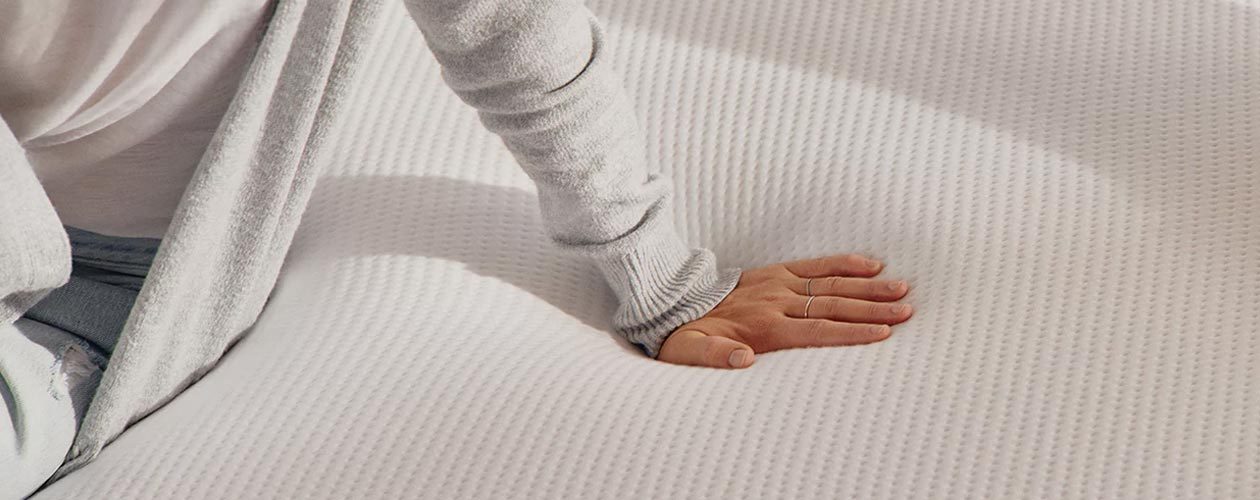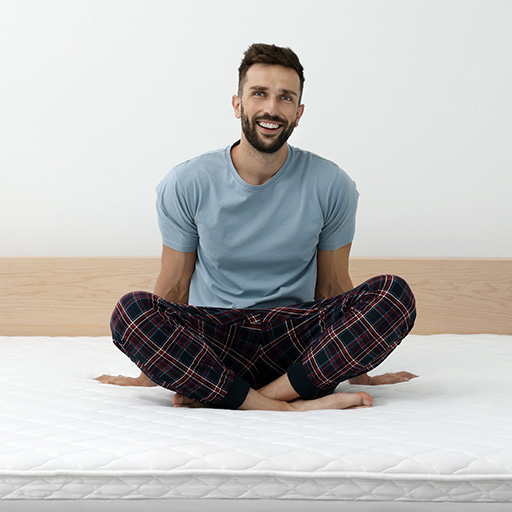Memory Foam vs. Hybrid Mattress
Not all mattresses are created equal. A lot about a bed can be chalked up to personal preference, but there are a few situations where you’ll be better served with a certain kind. That brings us to a new category of mattress, the Hybrid. The distinction between spring and memory foam mattresses is pretty clear,…
Not all mattresses are created equal. A lot about a bed can be chalked up to personal preference, but there are a few situations where you’ll be better served with a certain kind.
That brings us to a new category of mattress, the Hybrid. The distinction between spring and memory foam mattresses is pretty clear, but a hybrid can blur the lines a bit. Let’s break everything down so you can decide once and for all if you’re a memory foam purist or you like to have a little something unexpected in your mattress.
In This Article
Construction
Old types of mattress didn’t have much going on. They were mostly interlocking springs that provided support with a superficial layer of comfort materials. They weren’t very comfortable because they forced your body to conform to the mattress itself instead of cradling your curves.
Softer versions just sagged in the middle, offering very little support overall. They contributed to back pain because your spine wasn’t adequately supported.
So how do modern beds handle this issue? Let’s look.
Memory Foam
Memory foam uses several different layers of foams with different densities. The top layers give way underneath your broadest points so that places like shoulders and hips sink further into the mattress. The materials fill in around gaps such as your waist and lower back.
The denser layers beneath push back against your weight, preventing you from overextending your spine. They also give the mattress structural integrity.
Memory foam mattresses have a wide variety of numbers of layers, but there are always at least two, contouring and supporting layers.
Hybrid
Hybrid mattresses look a lot like innerspring mattresses. They use coils as the support layer instead of dense support foam.
What makes hybrids different from spring or memory foam are the layers. The top layers are contouring layers made of different materials such as memory foam and latex. They’re set up like innerspring, but they often have bigger, more elaborate layers of comfort materials.
Sometimes, contouring layers include things like a layer of micro-coils to improve transition and responsiveness. Other things include layers of both memory foam and latex or pillow top layers with organic cotton batting. Each layer creates a different effect for contouring, response, or other benefits.
The coil layers are individually pocketed, so they respond without interfering with each other. The general wisdom is the more the coils, the better the contouring. The coils react to your weight and help keep your spine aligned. They also give the mattress structural integrity.
Some even have foam bases and reinforcement around the edges.
Edge Support
The edge support of the mattress helps you when you’re sitting or sleeping at the edge of the mattress. Couples on a bed with poor edge support might have trouble using all the mattress real estate, fighting over the sweet spot in the middle. It also allows you to sit on the edge of the mattress when you’re tying your shoes or just philosophizing about your life.
Let’s look at the differences.
Memory Foam
Memory foam hasn’t always held up regarding edge support. Foam doesn’t always have the structural integrity to hold up weight without compression. The softer layers on top are made to give way, and the dense foam underneath can’t always counteract that effect.
Modern memory foam mattresses sometimes use latex layers which don’t have as much compression or other transitional layers. Transitional layers don’t interfere with the contouring layers, but they do offer more support, working with the dense layer to handle the weight at the edge.
Others reinforce the edges with thicker foams to help hold the mattress in place. Now, many memory foam options have better edge support. Make sure your memory foam mattress has this good edge support since this is a risk with all memory foam. You won’t fight over the sweet spot as a couple, and you can sit on the edge of the bed without worrying.
Hybrid
Hybrids are a lot better with edge support. Using a layer of coils or a microlayer and standard layer. They’re more durable and can withstand greater amounts of weight without compression.
The contouring layers are more supportive as well. They’re frequently transitional layers of adaptive foam or latex that can handle the weight as well. Some hybrids use base layers of dense foams to help further support coils and keep the entire support core consistent whether the middle or the edge.
Hybrids are better if you’re heavier than the average person, especially if you’re part of a couple. Couples need to use every inch of mattress real estate and can’t afford to have spots towards the ends that aren’t as supportive.
Motion Isolation
When you wake up in the middle of the night because your partner or your dog is moving around and it jiggles your side of the mattress, that’s frustrating. Conventional mattresses had interlocking springs that affected each spring around them. If your partner is a sleeping hula dancer, you’re going to feel it.
How do hybrid mattresses and memory foam mattresses handle motion transfer? Let’s look.
Memory Foam
What memory foam lacks in edge support, it makes up for with motion isolation. Foam has no interlocking parts, so motion transfer is dampened almost to nothing. Foam is a bit like sand. Motion in one place doesn’t have a significant effect on the rest of the area.
When you move on one side of the bed, the contouring and supporting layers immediately dampen the motion, so the other side of the bed doesn’t feel anything at all. It’s great if you sleep with a restless sleeper, or if you’re a light sleeper yourself.
It’s also good because if one partner is a lot heavier than the other, motion isolation helps prevent indentations underneath the heavier partner. You won’t roll towards each other all night long (unless you want to).
One downside to this extreme motion isolation is it can take some getting used to when you’re changing positions. You don’t get the momentum of your body weight to help you change positions. It can also dampen couple’s activities because of the lack of bounce.
Hybrid
Hybrids are better than their innerspring counterparts just because of the amount of contouring layers. Some hybrids have multiple foam or latex layers that can prevent motion across the bed.
Most mattresses use pocketed coils now, which have less interaction with each other. This design also reduces motion transfer. However, you’re always going to have some measure of motion transfer because coils are just bouncier.
The upside to that is that couple’s activities are often more satisfying because the bounce lends itself to the rhythm. It also makes it a little easier to change positions or to get out of bed using the momentum of your body weight.
Temperature Regulation
If you’ve ever woken up hot and sweaty, or toss and turned looking for a cooler spot, you know how important it is that a mattress be breathable and help regulate your temperature. Let’s look at some ways memory foam and hybrid mattresses handle the temperature.
Memory Foam
Old memory foam was hot. It trapped your body heat and created pockets of hot spots that reflected back to you as you slept. It wasn’t ideal.
Newer memory foam models use a variety of methods to prevent heat from getting trapped in the foam. Many foams now are open-celled varieties that have air pockets. As you move around, air is forced from one pocket to the next, moving air and helping heat disperse.
Other methods are gel-infused foams or graphite infused foams. These materials draw heat from your body and continually move it through the mattress, dispersing it and returning the surface to ambient room temperature.
These are significant improvements over traditional memory foams. However, if you sleep cooler, simple, open-cell memory foams can help keep you at the right temperature without getting hot and sweaty.
Hybrid
Hybrids use several layers of foams or comfort materials. Many of them are open cell for the same breathability, and many are also gel or graphite infused. The coil layer is naturally more breathable because of the space between and around the coils. Air flows well in that layer prevent heat from building up in the core of the mattress.
If you choose a hybrid, make sure you take the comfort materials into account because those will determine a lot of the temperature close to your body. These can be great options for those who sleep very hot or for heavier people whose weight is part of their temperature regulation.
Allergies
Your mattress is a huge part of your allergies. If you haven’t replaced your mattress in a while, it might be time. Your bed can double in weight over the course of its lifetime in just dust mites and human skin cells. Gross.
Memory Foam
If you suffer from allergies, memory foam has the potential to change the way you sleep. The foams are naturally antimicrobial. They’re also naturally dust mite and bed bug resistant. That can be a huge relief if you have trouble with bed bugs in your area or if you know you’re highly sensitive to dust mites.
The downside is that memory foam is a petroleum-based product, so they’re subject to off-gassing. Foams have gotten better about the odors, but you’re still going to have at least a small amount of off-gassing. Look for foams certified as low emissions such as those with the CertiPur-US tag.
Hybrid
Hybrids have materials that are naturally better with allergies. The contouring layers are often naturally dust mite resistant and antimicrobial. Underneath, coils are one of the favorite hiding places of bed bugs. They’re protected within the spaces of the coils and have some space to get out during the night.
If you’re worried about bedbugs, total encasements can help you solve the problem without getting rid of your mattress completely. Again, make sure your materials are certified as low emissions such as those guaranteed by CertiPur-Us.
Firmness Options
Different preferences and sleep positions have an effect on your perfect firmness. Both memory foam and hybrids come in various options depending on the company. For both, the principle remains the same.
Soft mattresses are suitable for side sleepers because they have more give at the broadest points of the body. There should be some sort of support layer underneath to prevent your body from sinking too far into the mattress.
Stomach sleepers need very firm mattresses to prevent the spine from overextending. THose with back pain and back sleepers could also benefit from a firm mattress.
Medium-firm mattresses are widely considered to be the most comfortable. They’re suitable for those who have combination sleeping positions and couples with different preferences or primary positions.
Heavier people may need firmer mattresses that can support their weight without losing mattress integrity. It’s also a good idea to look for a bed that explicitly considers the weight of heavier than average people. This design can help prevent compression but allow for proper contouring.
Recommendations
You’ve made your decision. Now let’s look at a few of our top picks for both categories so you can get back to your best night of sleep.
Best Memory Foam – Puffy
Puffy is hands down one of our favorite foam mattresses. It uses a proprietary foam that actively wicks heat and moisture away from your body the way performance athletic wear does.
The original Puffy uses just two layers, a Cloud comfort layer with gel infusion for contouring and a dense support layer. It’s breathable and helps regulate your temperature. The Lux has three layers with a second, transitional layer of Cloud comfort foam to assist both the contouring layer and the support layer.
You have 101 nights to try the mattress out before deciding if it’s the right one. Make sure you give it some time, at least a few weeks, so you know for sure. It’s covered by a lifetime warranty against mattress defects.
Puffy doesn’t offer the option of white glove delivery, so you’ll have to set your mattress up yourself. It arrives at your door, safely compressed. Just unpack the box and tear the plastic away from the mattress. Allow it to inflate for a few hours and everything will be ready.
Most Affordable Option – Nectar
Nectar’s foam option is a single mattress that uses multiple layers to create contouring and support. The top two layers are gel infused. The quilted top layer provides loft and improves breathability. They both wick heat and moisture away from your body.
The next layer is a transitional layer of adaptive foam. It provides support for your spine and eases your body to the dense support layer.
It comes with a year-long trial period and a lifetime warranty. Their purchase terms are some of the best on the market, hands down. The best part? None of their mattress sizes are over $1000.
They don’t have the option of white glove delivery, so be sure you make arrangement for when your mattress arrives if you need help. Otherwise, unpack the box and tear the plastic away from the mattress to get started.
Tie – Best Hybrid Option – Dreamcloud
Dreamcloud is one of our favorite hybrid mattresses of all time. It uses eight different layers for content and support.
The first few layers are memory foam, one quilted and one gel-infused, for breathability and temperature regulation. The transitional layers use materials like latex for improved response and adaptive support. The coil layer is individually pocketed, so motion transfer is reduced.
Dreamcloud gives you a full year to try the mattress out and a full, lifetime warranty. It’s another company with some of the best purchase terms out there. Make sure you give it a few weeks to break it in and allow some of your old pressure points to heal.
Dreamcloud offers both standard shipping and white glove delivery. If you don’t need help, your mattress arrives compressed in a box. If you need professional installation, your delivery person will help you get everything set up.
Tie – Best Hybrid Mattress – Solay
One of our other favorite mattresses is Solay. It also uses a series of layers to provide contouring and support comes from the coil layer.
It uses two different foams on top, one gel infused for better temperature regulation, and a transitional layer of foam for adaptive support and motion isolation. A layer of full-sized coils, hundreds of them, are sandwiched between further layers of foam to help protect the body and reduce motion.
You have 101 nights to try the mattress out, and it’s covered by a 15-year warranty against mattress defects.
The mattress arrives compressed in a box. You don’t have the option of white glove delivery so make sure you make arrangements if you need help.
The best part of both Solay and Dreamcloud is that none of their mattress sizes will set you back more than $1500. They’re both equally affordable (although we’d go with Dreamcloud because of the purchase terms).
Final Thoughts
Hybrids can help you if you’d like the contouring benefit of memory foam but don’t want to give up the responsiveness of coils. Conversely, if you’re a light sleeper and don’t want the motion to wake you up, memory foam is probably better.








